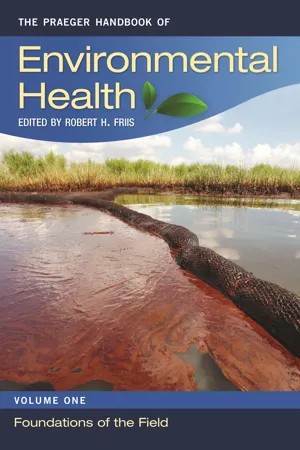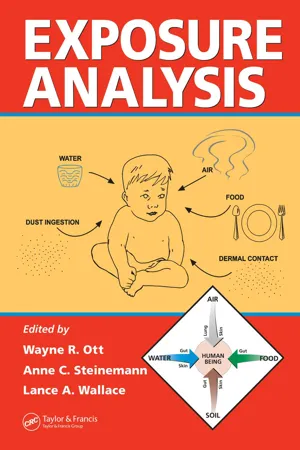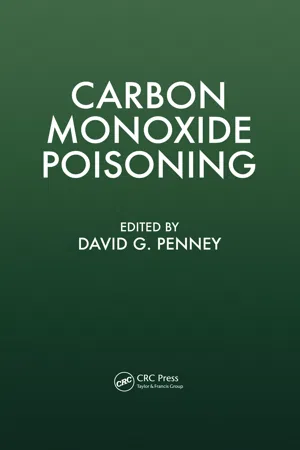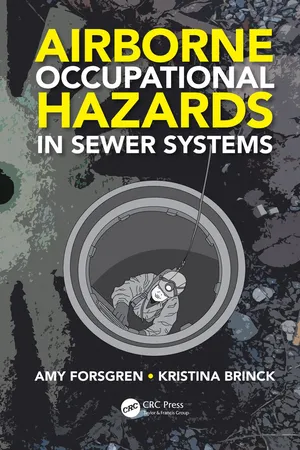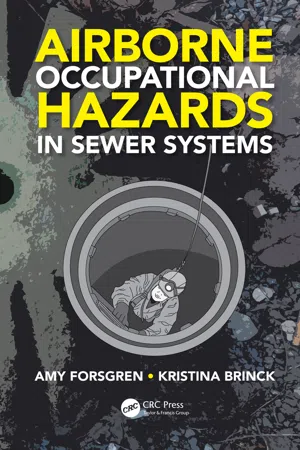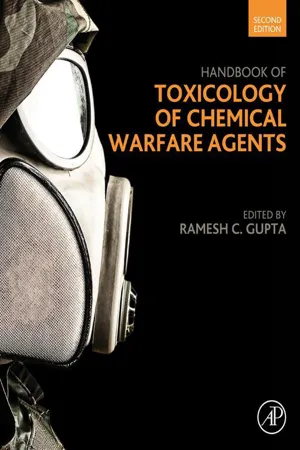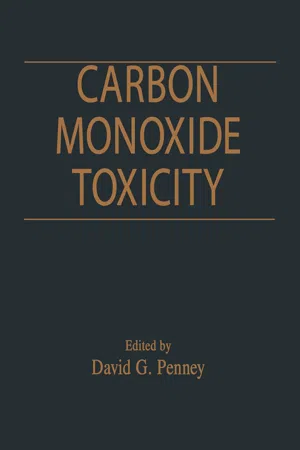Geography
Carbon Monoxide
Carbon monoxide (CO) is a colorless, odorless gas produced by the incomplete combustion of carbon-containing fuels. It is a significant air pollutant and can have harmful effects on human health, particularly when inhaled in high concentrations. In geographical terms, carbon monoxide emissions are often associated with urban areas and transportation sources.
Written by Perlego with AI-assistance
Related key terms
1 of 5
7 Key excerpts on "Carbon Monoxide"
- eBook - ePub
The Praeger Handbook of Environmental Health
[4 volumes]
- Robert H. Friis(Author)
- 2012(Publication Date)
- Praeger(Publisher)
12 Carbon Monoxide Poisoning: Health Effects, Surveillance, and Epidemiology
Shahed Iqbal and Fuyuen Y. YipIntroduction
Carbon Monoxide (CO) is a leading cause of poisoning in the United States and worldwide.1, 2 This colorless, odorless, tasteless nonirritant gas is ubiquitous in our environment at a low atmospheric concentration of 0.001 percent.3 Natural sources account for 40 percent of the total CO in the environment, and the rest is believed to be a result of anthropogenic activities.4 Carbon Monoxide is found in both indoor and outdoor environments and mixes thoroughly with surrounding air.5 Exposure to CO can result in diverse health outcomes, ranging from mild subclinical effects to death. The lack of color, odor, and taste makes CO imperceptible to human senses, making it a dangerous environmental exposure that is often termed the “silent killer.” Annually, CO poisoning is responsible for a large number of fire-related and suicidal injuries or deaths.6–9 9 However, this chapter mainly, albeit not exclusively, focuses on CO poisonings that result from unintentional and non-fire-related (UNFR) exposures (i.e., CO exposures that are not purposefully inflicted on self or others and that are not a result of a fire event).Sources
Carbon Monoxide has both endogenous and exogenous sources. It is produced in our bodies as part of a physiological process through oxidative metabolism of heme. The enzyme, heme oxygenase, is responsible for the production of CO that occurs mainly in the liver, spleen, and reticuloendothelial system.10, 11 Exogenously, CO is produced because of incomplete combustion of hydrocarbons during the burning of fuels (e.g., gasoline, kerosene, propane, natural gas, oil, wood, and coal).7 Major sources of CO exposure include12 - eBook - PDF
- Wayne R. Ott, Anne C. Steinemann, Lance A. Wallace(Authors)
- 2006(Publication Date)
- CRC Press(Publisher)
References ......................................................................................................................................141 6.1 SYNOPSIS Incomplete combustion of carbonaceous fuels (i.e., fuels with carbon atoms) can produce sig- nificant quantities of Carbon Monoxide (CO). Exposure to CO occurs during a variety of daily 114 Exposure Analysis activities such as traveling by motor vehicle in traffic or cooking food over an unvented gas range. Fortunately, reducing CO exposures has been one of the “… greatest success stories in air-pollution control,” according to a report published by the National Research Council in 2003. Much of that success is due to the adoption in 1968 of nationwide emission controls on new cars, and to promulgation in 1970 of the National Ambient Air Quality Standards (NAAQS) for CO and several other “criteria” air pollutants. In spite of that success, many people die or suffer the ill effects of high CO exposure every year. In fact, CO is the only regulated air pollutant that appears on death certificates. Accordingly, this chapter first summarizes the principal sources and health effects of CO. It then describes key studies of CO exposure over the last 40 years to show how the goals and methods of these studies have evolved over time. Studies of CO exposure in the 1960s and 1970s essentially pioneered the field of exposure analysis. The earliest studies found that CO concentrations on congested roadways and busy intersections in downtown areas typically exceeded ambient CO levels measured at fixed-site monitors. The U.S. Environmental Protection Agency (USEPA) relies on these monitors to determine compliance with the NAAQS. The chapter reveals typical concentrations of CO that people encounter in their daily lives and identifies factors that affect or contribute to CO exposures as a person performs his or her daily activities. - eBook - PDF
- David G. Penney(Author)
- 2007(Publication Date)
- CRC Press(Publisher)
12 Investigating Carbon Monoxide Poisonings Thomas M. Dydek CONTENTS 12.1 Introduction ................................................................. 287 12.2 Signs and Symptoms of Carbon Monoxide Poisoning .................... 288 12.3 Assessments of Carbon Monoxide Exposure Level and Duration ........ 289 12.3.1 Carboxyhemoglobin Levels as a Measure of Carbon Monoxide Exposure ............................................................ 290 12.3.2 Occupational Exposure Standards for Carbon Monoxide ........ 291 12.3.3 Community Exposure Standards and Guidelines for Carbon Monoxide ........................................................... 291 12.3.4 Carbon Monoxide Exposure Duration Assessments .............. 292 12.4 Treatments for Carbon Monoxide Poisoning .............................. 295 12.5 Other Factors to Consider in Investigations of Carbon Monoxide Poisoning .................................................................... 296 12.6 Case Study of Carbon Monoxide Poisoning ............................... 297 12.7 Summary .................................................................... 299 References ......................................................................... 300 12.1 INTRODUCTION Carbon Monoxide (CO) is a colorless, odorless, tasteless, and potentially toxic gas. These properties have earned it the title of “the silent killer”. 1 CO poisoning is responsible for more than one half of the poisoning fatalities reported in this country every year. It is the leading cause of death in industrial accidents as well. Fatalities and CO-related injuries are also common throughout the world. Another factor that makes CO an especially dangerous toxin is that the early symptoms of poisoning are easily confused (and often misdiagnosed) as the onset of a cold or the flu, stomach virus, or other common diseases. 2 CO is produced by natural sources and by man-made sources. - Amy Forsgren, Kristina Brinck(Authors)
- 2016(Publication Date)
- CRC Press(Publisher)
159 9 Other Vapors or Gases 9.1 Carbon Monoxide Carbon Monoxide (CO) is a highly flammable, highly toxic gas, created by incomplete combustion.* CO is one of the most common sources of poison- ing deaths in the world [1,2]. CO is the most common cause of fatal gas inhalation exposures in the U.S. workplace, accounting for 36% of the deaths. Estimates of the annual number of unintentional deaths in the United States due to CO poisoning range from 300 to 900 † [3–6]. In 1997, CO poisoning caused 108 unintentional deaths in England and Wales [7]. 9.1.1 Properties Table 9.1 shows some important physical and chemical properties of CO. CO is a flammability hazard—the flammability range is quite extensive, 12.5%–74%. However, its toxicity is what kills. The density of this gas is very close to that of air, so it can disperse fairly easily. Pockets of CO can form, however, in areas with little air movement. 9.1.1.1 Other Names CO is known as white damp, coal gas, and flue gas. 9.1.2 How Carbon Monoxide Kills CO is a chemical asphyxiant. It prevents oxygen from reaching the tissues of the body in sufficient quantities to sustain life. Normally, the protein hemo- globin in the red blood cells takes up oxygen (forming oxyhemoglobin) and distributes it throughout the body. CO interferes with this by competing with oxygen for the binding sites on the hemoglobin. Approximately 95% of * Plants can also produce CO as a metabolic by-product [5] but not in the amounts needed to cause CO poisoning. † The lower numbers reflect non-fire-related CO poisonings. 160 Airborne Occupational Hazards in Sewer Systems the CO binds to the hemoglobin to form carboxyhemoglobin (COHb), which is useless for distributing O 2 around the body. Tissue hypoxia results. The tissue hypoxia has the greatest effect on tissues that extract high percentages of the available oxygen, such as the brain and heart [7–9]. CO has a higher affinity than O 2 to the hemoglobin in the red blood cor- puscles.- eBook - ePub
- Amy Forsgren, Kristina Brinck(Authors)
- 2016(Publication Date)
- CRC Press(Publisher)
9Other Vapors or Gases
9.1Carbon Monoxide
Carbon Monoxide (CO) is a highly flammable, highly toxic gas, created by incomplete combustion.* CO is one of the most common sources of poisoning deaths in the world [1 ,2 ].CO is the most common cause of fatal gas inhalation exposures in the U.S. workplace, accounting for 36% of the deaths. Estimates of the annual number of unintentional deaths in the United States due to CO poisoning range from 300 to 900† [3 , 4 , 5 and 6 ]. In 1997, CO poisoning caused 108 unintentional deaths in England and Wales [7 ].9.1.1Properties
Table 9.1 shows some important physical and chemical properties of CO.CO is a flammability hazard—the flammability range is quite extensive, 12.5%–74%. However, its toxicity is what kills. The density of this gas is very close to that of air, so it can disperse fairly easily. Pockets of CO can form, however, in areas with little air movement.9.1.1.1Other Names
CO is known as white damp, coal gas, and flue gas.9.1.2How Carbon Monoxide Kills
CO is a chemical asphyxiant. It prevents oxygen from reaching the tissues of the body in sufficient quantities to sustain life. Normally, the protein hemoglobin in the red blood cells takes up oxygen (forming oxyhemoglobin) and distributes it throughout the body. CO interferes with this by competing with oxygen for the binding sites on the hemoglobin. Approximately 95% of the CO binds to the hemoglobin to form carboxyhemoglobin (COHb), which is useless for distributing O2 around the body. Tissue hypoxia results. The tissue hypoxia has the greatest effect on tissues that extract high percentages of the available oxygen, such as the brain and heart [7 , 8 and 9 - Ramesh C Gupta, Ramesh C. Gupta(Authors)
- 2015(Publication Date)
- Academic Press(Publisher)
Wherever there is combustion there is CO; it is the predominant product above 800°C. The concentration of CO might vary from 0.1 ppm in clean atmosphere to 5,000 ppm in the proximity of domestic wood fire chimneys (Fawcett et al., 1992) and is present in significant quantities in cigarette smoke (Hartridge, 1920 ; Hoffmann et al., 2001). The atmospheric lifetime of CO is 1–2 months, which allows its intercontinental transport (Akimoto, 2003). The universal presence and unsuspecting inhalation of CO make it the most common source of poisoning in the modern world and the leading cause of unnatural death in the United States. However, CO is not on the list of chemicals used as chemical weapons in wars (Elsayed and Salem, 2006), although there are reports that the Nazis used CO gas against Jewish people during 1941 because CO was cheaper than bullets. Mysterious illnesses, strange visions, and inexplicable deaths of entire households, generally attributed to haunted houses, are most likely due to malfunctioning chimneys, resulting in Carbon Monoxide poisoning. Even nonlethal concentrations of CO can exert dramatic effects in the presence of preexisting cardiac diseases. Continued exposure to relatively high, yet nonlethal, concentrations of CO can adversely affect a pregnant woman and her fetus. CO is a contributory factor in the adverse effects of smoking (United Nations Environment Program and WHO, 1979 ; Akrawi and Benumof, 1997); moreover, smokers occasionally set the entire home on fire, producing excessive quantities of CO (Sacks and Nelson, 1994). CO is also endogenously generated. CO is a bit like other endogenous gases of great physiological and pathological significance such as O 2, NO, and hydrogen sulfide (H 2 S)- eBook - PDF
- David G. Penney(Author)
- 2000(Publication Date)
- CRC Press(Publisher)
345 0-8493-2065-8/00/$0.00+$.50 © 2000 by CRC Press LLC 15 Carbon Monoxide Air Pollution and Its Health Impact on the Major Cities of China Qing Chen and Lihua Wang CONTENTS 15.1 Carbon Monoxide in Ambient Air in China’s Major Cities ..................... 345 15.2 Health Effects of Automobile Exhaust on Traffic Police ......................... 349 15.3 Levels of Indoor Air Carbon Monoxide in the Residential Districts ....... 351 15.3.1 Methods of Heating ..................................................................... 351 15.3.2 Types of Residential Quarters ..................................................... 352 15.3.3 The Kitchen .................................................................................. 354 15.4 Derivation of Hygienic Standards for Carbon Monoxide in Ambient Air ............................................................................................... 354 15.5 Related Studies .......................................................................................... 358 References .............................................................................................................. 360 15.1 Carbon Monoxide IN AMBIENT AIR IN CHINA’S MAJOR CITIES Before 1980, the traditional method to make use of energy was the burning of coal directly. About 80% of fuel is used in this way in the whole country. A great number of industrial furnaces have rather short chimneys. The exhaust air is released into the ordinary air. Hence, ashes and substances that have not been burned completely spread in large measure into the living environment. Vast territories in north China have a long heating season of about 4 to 6 months per year. Small stoves are very common utensils for cooking and keeping warm in a household. When coal is burned in a stove, a great number of ash particles are exhausted with the gases. Among the exhaust gas, sulfur dioxide (SO 2 ), Carbon Monoxide (CO), and other compounds are pollutants harmful to human health.
Index pages curate the most relevant extracts from our library of academic textbooks. They’ve been created using an in-house natural language model (NLM), each adding context and meaning to key research topics.
